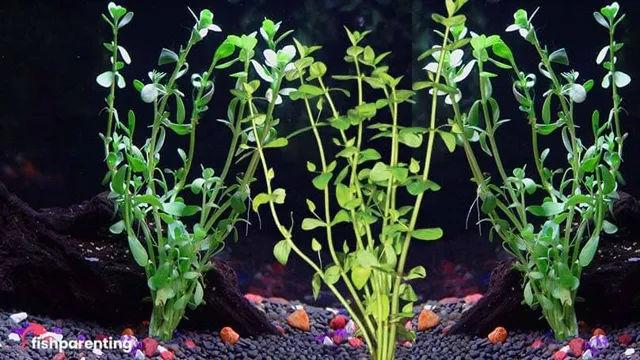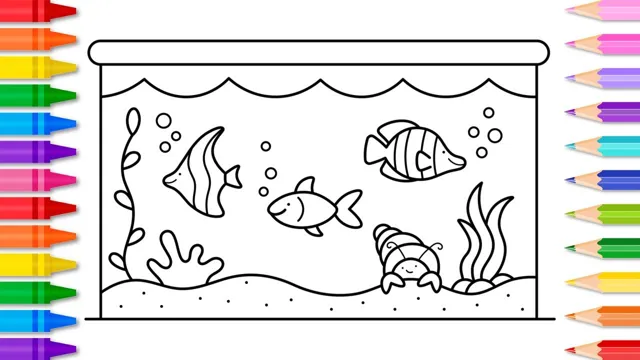How to Achieve Clear Aquarium Water: Tips and Tricks for Crystal-Clear Tanks!

Having a clear and beautiful aquarium is the dream of any aquatic hobbyist. However, the struggle to achieve crystal clear water in an aquarium can be a challenge. There is nothing more frustrating than trying everything in your power and still having murky water in your tank.
A healthy and clear aquarium requires more than just regular cleaning and maintenance. It requires knowledge about the fish species, proper filtration, water chemistry, and the proper amount of lighting. In this blog, we will cover some of the essential tips and techniques on how to achieve clear aquarium water and maintain it for years to come.
Are you ready to dive into the world of aquatic maintenance and enjoy the beauty of crystal clear water in your aquarium? Let’s begin!
Monitor Water Parameters
One of the crucial steps to achieving clear aquarium water is by monitoring water parameters. This ensures the vital elements necessary for your aquatic pets are consistent and within a healthy range. One important parameter to monitor is pH, which should be maintained within a range suitable for your fish species.
Another crucial element is Ammonia, which can be toxic to fish and should be kept at a low level, ideally zero. Nitrate levels should also be monitored, as excessively high concentrations can cause health issues for your fish. Regular water changes can help keep nitrate levels within the acceptable range.
Maintaining proper water parameters not only ensures clear water but also promotes a healthy environment for your fish to thrive.
Test water for pH, ammonia, nitrite, and nitrate levels
As an aquarium owner, it’s important to monitor the water parameters to ensure a healthy environment for your fish and aquatic plants. Testing the water for pH levels, ammonia, nitrite, and nitrate levels is crucial in maintaining the well-being of your aquatic pets. The pH level of your aquarium’s water is important because it affects the health and growth of your fish and plants.
An imbalance in pH levels can lead to stress and even death in fish. Similarly, ammonia, nitrite, and nitrate levels can cause harm to your aquarium’s inhabitants if they are not kept in check. High levels of ammonia can cause burns and tissue damage in fish while high nitrite and nitrate levels can lead to oxygen depletion and toxic buildup in the water.
Hence, regularly testing and monitoring these parameters can give you insight into the condition of your aquarium’s water and help you maintain a healthy aquatic environment.

Maintain ideal levels through water changes and proper filtration
Keeping your aquarium water in ideal condition is essential for the health and happiness of your aquatic pets. One of the most critical factors to consider is water parameters. Regularly monitoring the pH level, ammonia, nitrates, and nitrites is vital to ensure a healthy environment for your fish to thrive in.
You can use test kits to quickly and easily measure these levels. Maintaining ideal levels of each parameter can be achieved with proper filtration and regular water changes. Proper filtration involves choosing the right type of filter for your aquarium, depending on the size and type of fish you have, as well as their waste production.
Regular water changes remove any dissolved waste and toxins that can accumulate in the water, keeping it fresh and clean. You should replace 10% to 20% of your water weekly to help keep it stable. By monitoring your water parameters and maintaining ideal levels through proper filtration and water changes, you can ensure that your aquatic pets stay healthy and happy.
Clean Filter Regularly
Maintaining clear aquarium water can be quite challenging, but one of the most important things you can do is to clean your filter regularly. An aquarium filter acts as a mechanical, biological, and sometimes chemical filtration system that helps keep the water free from dirt, debris, and harmful toxins that can harm your fish. Over time, the filter can become clogged with all sorts of particles, reducing its effectiveness.
That’s why it’s essential to clean the filter regularly to keep it functioning optimally. To clean the filter, remove it from the aquarium and take it apart, rinse it under running water, and scrub away any debris with a soft brush. Be sure to replace any worn or damaged parts and follow the manufacturer’s instructions for putting it back together.
Regular filter cleaning is crucial in creating and maintaining a healthy and clear aquarium environment for your fish to thrive.
Remove debris and rinse filter media
Regularly cleaning your aquarium filter is crucial in keeping your fish healthy and your tank clean. One of the key steps in maintaining your filter is removing any debris and rinsing your filter media regularly. This ensures that the filter is functioning properly and can effectively remove any harmful pollutants from the water.
Neglecting to clean your filter can lead to a buildup of waste and bacteria, eventually leading to poor water quality and even sickness in your fish. So, be sure to schedule regular filter maintenance to keep your aquarium thriving. Remember, a well-functioning filter is the cornerstone of a healthy aquarium! (See Also: How to Make a CO2 System for an Aquarium: A Step-by-Step Guide)
Replace filter media as needed
One of the most important things you can do to keep your aquarium healthy is to regularly clean your filter. Not only does this improve the overall look and environment of your tank, but it also ensures that your fish and other aquatic creatures are staying healthy and happy. Part of this process includes replacing filter media as needed.
Over time, filter media can become clogged with debris and contaminants, reducing its effectiveness. It’s recommended that you check your filter media monthly, and replace or clean it as needed. This helps to maintain a healthy balance of bacteria and other microorganisms in your tank, which is essential for keeping your fish and other aquatic creatures healthy.
By taking this simple step, you can ensure that your aquarium stays beautiful and vibrant, providing a stunning display for you and your family to enjoy for years to come.
Use Activated Carbon
One effective way to achieve clear aquarium water is by using activated carbon. This product is a powerful absorbent that can effectively remove pollutants, chemicals, toxins, and other impurities from the water, which can help improve its clarity. Activated carbon works by attracting and binding to the compounds responsible for water cloudiness, making it easier for the filter to remove them from the water.
It’s easy to use, you just need to place it in a filter bag and put it in your aquarium filter. It’s important to note that activated carbon needs to be replaced periodically, so make sure to follow the manufacturer’s instructions on when to change it. Using activated carbon in your aquarium can help keep your fishes healthy and happy, and ensure that they have a clean and clear environment to thrive in.
Absorbs impurities and odors
Activated Carbon Activated carbon is incredibly effective at absorbing impurities and odors, making it a popular choice in many applications. It works by attracting and binding to unwanted substances, leaving the surrounding area clean and fresh. This makes it an excellent addition to products such as air purifiers, water filters, and even face masks.
Activated carbon is made by heating carbon-rich materials, such as coconut shells or wood, in the absence of oxygen. This process creates pores in the material, which greatly increases its surface area and therefore its ability to absorb impurities. It’s a highly versatile material that can be used in a wide range of applications, making it an excellent choice for those looking to improve air and water quality or reduce unpleasant odors.
Whether you’re looking to purify your home’s air or filter your drinking water, activated carbon is a powerful tool that can help you achieve your goals. So why not try incorporating it into your daily life today?
Replace every 4-6 weeks
Aquarium maintenance is key to keeping your aquatic pets healthy and happy. One important aspect is replacing the filter media every 4-6 weeks. An easy and effective way to filter your aquarium water is by using activated carbon.
Activated carbon works by trapping impurities and removing discoloration from the water. It also helps to control odors and prevent bacterial growth. When replacing your filter media, it is essential to use high-quality activated carbon that suits your aquarium size.
Cheap carbon may not work effectively and could even release toxins into the water. It’s always best to follow the instructions on the packaging and replace the carbon as recommended. By using activated carbon, you can maintain a clear and healthy environment for your aquatic pets.
Avoid Overfeeding
If you’re struggling with cloudy water in your aquarium, one common culprit may be overfeeding your fish. It’s important to remember that fish only need to be fed once or twice a day, and very little at that. Overfeeding can lead to excess food accumulating in the tank, which can break down and produce waste, leading to cloudy water.
Additionally, uneaten food can end up clogging filters and drains, further exacerbating the problem. To avoid overfeeding, try feeding your fish smaller portions and monitoring their behavior to see if they’re still hungry. It may also be helpful to use a feeding schedule or automatic feeder to ensure consistent portion sizes.
By taking steps to avoid overfeeding your fish, you can help keep your aquarium water clear and healthy for your aquatic pets.
Feed only what fish can consume in 2-3 minutes
Overfeeding is a common mistake many fish owners make when feeding their aquatic pets. It may seem like a good idea to give your fish a little extra food to ensure they are well-fed, but it can actually be harmful to their health. Overfeeding can lead to a variety of issues such as bloating, constipation, and even death in extreme cases.
To avoid overfeeding your fish, it is important to feed them only what they can consume in 2-3 minutes. This means paying close attention to the amount you are feeding and removing any uneaten food from the tank. By feeding your fish in this manner, you can ensure they are receiving proper nutrition without putting their health at risk. (See Also: How to Aquarium Siphon: A Complete Guide for Beginners)
Remember, just like with any other pet, it is essential to maintain a proper diet and feeding schedule for your fish to keep them healthy and happy.
Remove uneaten food promptly
If you’re a pet owner, then you know how easy it is to get carried away with feeding your furry friends. However, overfeeding your pets can actually harm them in the long run. It’s important to stick to the recommended guidelines for your pet’s specific breed and size.
Not only will overfeeding lead to weight gain, but it can also cause digestive issues and even diabetes. Always be mindful when feeding your pet, and remove any uneaten food promptly. This will not only prevent any potential overeating, but it also ensures that the food stays fresh and doesn’t attract any unwanted pests.
Remember, a healthy pet is a happy pet. So, avoid overfeeding and keep your pet on a balanced and nutritious diet.
Maintain Good Aquarium Habit
Achieving clear aquarium water is an essential aspect of keeping fish healthy and happy. One of the most effective ways to do this is to maintain good aquarium habits. There are several ways to achieve this, and it starts with cleaning your tank regularly.
Over time, fish waste, food residue, and plant decay can build up in the water, leading to cloudy water. To prevent this, you should remove any waste or uneaten food promptly. Another important aspect is to change the water on a regular basis.
Aim to change about 10-20% of the water every week, depending on the size of the aquarium. This will help to remove any contaminated water and the build-up of nitrates. Additionally, introducing live plants to your aquarium is a great way to improve water quality.
Not only do they absorb harmful chemicals, but they also produce oxygen and improve the water’s overall clarity. Proper lighting also plays a crucial role in maintaining good aquarium health. Make sure you provide the right amount of light for your plants and fish, and ensure your aquarium is not overexposed to natural light.
Lastly, investing in a high-quality filter is a must. It effectively removes any debris from the water and helps to keep it crystal clear. By following these simple tips, you can prolong the lifespan of your fish and maintain a beautiful, healthy aquarium environment.
Avoid overcrowding
When it comes to maintaining a healthy aquarium, one of the most important things to keep in mind is to avoid overcrowding. While it may be tempting to pile your tank with all sorts of fish, plants, and decorations, doing so can actually be harmful to the inhabitants of your aquarium. Overcrowding can cause stress and lead to territorial disputes, which can result in aggression and even death.
To avoid this, make sure to research the ideal number of fish and other organisms for your tank size and type, and make sure to provide ample space and hiding spots for each of them. By maintaining good aquarium habits like avoiding overcrowding, you can help ensure the health and happiness of your aquatic friends.
Provide adequate aeration and circulation
One of the most important things you can do to maintain a healthy aquarium is to provide adequate aeration and circulation. There are a few reasons why this is so important. First, it helps to distribute oxygen throughout the tank, ensuring that your fish have enough to breathe.
Without adequate oxygen levels, your fish can become stressed, which can lead to illness or even death. Second, good circulation helps to remove harmful waste products from the tank. These waste products can build up over time and create a toxic environment for your fish.
By providing good circulation, you can help to keep your tank clean and healthy. Finally, good circulation helps to regulate the temperature in your tank. This is especially important if you have tropical fish, which require a specific temperature range to thrive.
By keeping the water temperature consistent throughout the tank, you can help to ensure the health and wellbeing of your fish. So, if you want to keep your aquarium healthy and thriving, be sure to provide good aeration and circulation. Your fish will thank you! (See Also: How to disinfect aquarium plants with bleach – a step-by-step guide)
Perform regular water changes
As aquatic enthusiasts, we all want our aquariums to remain clean and healthy for our fish to thrive. One of the most crucial habits in maintaining a healthy aquarium is performing regular water changes. Water changes are essential because they reduce the buildup of harmful toxins and nitrates that can harm fish and other aquatic life.
By removing a portion of the water in your tank, you help restore the water’s balance and prevent the build-up of contaminants. Experts recommend changing at least 25% of your aquarium’s water every two weeks. Doing so will keep your fish healthy and happy, and also help maintain the overall cleanliness of the aquarium.
It’s essential to make sure you never rely entirely on a filtration system to remove all the toxins from the water. A filter only removes physical debris and pollutants; it doesn’t remove nitrates, which can only be eliminated through water changes. By practicing this hospital-grade habit, you can ensure that your aquatic pets will continue to flourish and remain healthy and vibrant for years to come.
So, are you ready to change the water in your aquarium?
Conclusion
In conclusion, achieving clear aquarium water may seem like a daunting task, but with the right steps and proper maintenance, it is possible. It’s like trying to achieve a clear mind, it takes patience, consistency, and a little bit of effort. So, don’t stress, keep a balanced ecosystem, avoid overfeeding and overcrowding, perform regular water changes, maintain filters, and your fish will swim in crystal clear water that even the most demanding critics would envy.
Remember, the key here is to go with the flow, literally!”
FAQs
Why is my aquarium water cloudy?
Cloudy aquarium water can be caused by various factors such as overfeeding, overstocking, and poor filtration. To achieve clear aquarium water, it is essential to identify and address the underlying issue.
What are some ways to improve aquarium water clarity?
Some ways to improve aquarium water clarity include:
– Performing regular water changes
– Using high-quality filtration systems
– Avoiding overfeeding and overstocking
– Keeping aquarium decorations and equipment clean
– Introducing live plants that help absorb excess nutrients
Can adding chemicals or clarifiers help with cloudy water?
While adding chemicals or clarifiers can provide temporary relief for cloudy water, they do not solve the underlying issue and can sometimes cause more harm than good. It is essential to address the root cause of cloudy water rather than relying solely on quick-fix solutions.
How often should I do water changes to maintain clear aquarium water?
The frequency of water changes depends on the size of the aquarium, the number of fish, and the type of filtration system used. A general rule of thumb is to aim for a 10-20% water change every 1-2 weeks.
Can UV sterilizers help achieve clear aquarium water?
Yes, UV sterilizers can be an effective tool for achieving clear aquarium water by killing off harmful bacteria and pathogens that can contribute to cloudiness. However, it is essential to use them correctly and maintain them properly.
Can adding more plants to my aquarium help achieve clear water?
Yes, adding live plants to an aquarium can help achieve clearer water by absorbing excess nutrients and providing oxygen to the water. It is important to research the specific plant species that are compatible with your aquarium and water parameters.
How can I prevent algae growth that can cause cloudy water?
Algae growth can be prevented by reducing the amount of light exposure to the aquarium, keeping the aquarium clean, avoiding overfeeding, and ensuring proper filtration. Additionally, introducing algae-eating fish or adding chemical treatments can help control algae growth.






